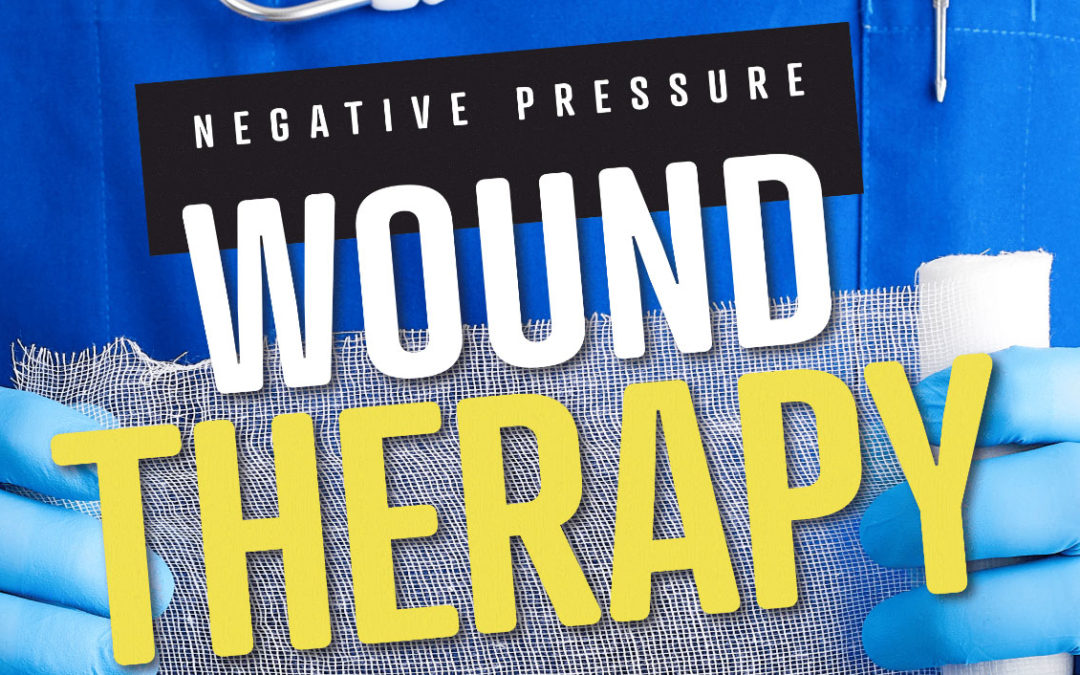
By Don Sadler
Negative pressure wound therapy (NPWT) isn’t new – it was first developed in the 1980s. But it’s becoming more common in clinical practice today as the body of evidence supporting its use in the promotion of wound healing grows.
In particular, two recent studies have demonstrated the effectiveness of using NPWT in reducing surgical site infections (SSIs). In both studies, there were significantly fewer SSIs among the patients who were treated using NPWT than among the patients who were treated using standard closure.
What is NPWT?
WoundEducators.com explains that negative pressure wound therapy “uses vacuum therapy in the form of a dressing applied to an acute or chronic wound. The vacuum pressure is controlled at a sub-atmospheric pressure and may be intermittent or constant. The wound is covered by a dressing which is sealed and then connected to a vacuum pump.”
“Negative pressure wound therapy was instrumental in changing soft tissue defect management,” says Julie Cahn, DNP, RN, CNOR, RN-BC, ACNS-BC, CNS-CP, perioperative practice specialist with the Association of periOperative Registered Nurses (AORN). “It has a multifocal mechanism of action that promotes wound healing.
“First, the removal of cells and fluid from the wound decreases the local inflammatory response,” Cahn continues. “When fluid is drawn away from the wound surface, this decreases the tissue breakdown that occurs from prolonged exposure to moisture while increasing oxygenation in the wound.”
These actions increase perfusion to the area, which promotes increased fibroblast growth and migration into the wound to form granulation tissue. “This type of dressing can be applied to acute surgical wounds and chronic wounds,” says Cahn.
She explains that there are three different types of wound closure: primary closure (or primary union or intention), typically with suture; delayed primary closure, which occurs when the wound is left open at the end of surgery; and healing by secondary intention, or granulation.
“With granulation, the wound is left open to heal from the bottom up as granulation tissue slowly closes the wound,” says Cahn. “Negative pressure wound therapy is most commonly used for these types of wounds.”
According to WoundEducators.com, NPWT promotes wound healing by removing infectious materials and barriers to cell proliferation/migration, thereby promoting granulation. It also provides a moist, protected wound care bed, promotes tissue perfusion, removes wound exudate and reduces tissue edema.
Revolutionizing Wound Management
“Negative pressure wound therapy has revolutionized the way we manage wounds that before were very difficult,” says Richard Schlanger, M.D. PhD, retired associate professor of surgery at the Ohio State University and director of wound care at Select Specialty Hospital East in Columbus, Ohio. “It whisks away excess fluid to allow for better wound healing.”
In addition, NPWT causes angiogenesis, or the creation of new blood vessels in the wound. “This brings cells and nutrients to promote wound healing,” says Schlanger.
Another benefit of NPWT is limited manipulation of the wound by nurses due to dressing changes. “The dressing is only changed every two or three days during the first week after surgery, so the wound is better protected,” says Schlanger.
WoundEducators.com lists many different types of wounds that can benefit from NPWT, including the following:
- Traumatic wounds
- Dehisced wounds
- Partial-thickness burns
- Pressure ulcers
- Diabetic ulcers
- Grafts and flaps
Schlanger says that when wounds aren’t sealed properly like they are when NPWT is used, “there’s a stronger possibility of infection even when the patient’s temperature is normal, oxygenation is good and glucose is under control. These are the factors we usually look for when wounds aren’t healing properly.”
“Negative pressure wound therapy is a very eloquent solution to these problems,” says Schlanger. “It also eliminates a lot of post-op headaches because all the excess fluid goes into a canister. It’s a one-way valve, unlike a semi-closed dressing device.
“The integrity of the post-op field is maintained in a semi-sterile condition,” Schlanger adds. “This cuts down on incidents of surgical site infections.”
Studies Evaluate Use of NPWT
In 2017, a study was conducted to evaluate the efficacy of negative pressure wound therapy for SSIs after open pancreaticoduodenectomy.
“Despite improvement in infection control, SSIs remain a common cause of morbidity after abdominal surgery,” stated the report’s authors. “SSI has been associated with an increased risk of reoperation, prolonged hospitalization, readmission and higher costs.”
The researchers randomly assigned patients to receive negative pressure wound therapy or a standard wound closure. The primary end point of the study was the occurrence of a postoperative SSI.
The result: SSI occurred in 31.1% of patients in the standard closure group, but just 9.7% of patients in the negative pressure wound therapy group. This corresponded to a relative risk reduction of 68.8%. What’s more, SSIs were found to independently increase the cost of hospitalization by 23.8%, according to the report.
“The use of negative pressure wound therapy resulted in a significantly lower risk of SSIs,” the report’s authors concluded. “Incorporating this intervention in surgical practice can help reduce a complication that significantly increases patient harm and health care costs.”
Another study conducted in 2017 examined the individual effect of closed surface NPWT on SSI reduction in lower extremity excisions. About half of the patients received closed surface NPWT and half received standard dressings. Between the groups, there were no major differences in mean age or body mass index, perioperative transfusions, use of prosthetic, reoperative field, dialysis status and presence of diabetes.
The result: There were significantly fewer SSIs among patients who received NPWT dressings (9.8%) compared to patients who received standard dressings (19.0%).
“The use of negative pressure wound therapy devices decreases the incidence of infrainguinal wound infections,” the report’s authors concluded. “This occurs as an independent factor as part of a patient care bundle targeting modifiable variables in perioperative care.”
Are There Drawbacks to NPWT?
Schlanger says that cost is probably the biggest drawback to NPWT. “However, new products over the past few years like disposable wound VACs are significantly less expensive than traditional wound VACs.”
“I’ve been very happy with these, especially with large patients and those with multiple laparotomies,” Schlanger adds. “I use the wound VAC immediately post-operatively instead of waiting for something to happen.”
In addition, disposable wound VACs are useful for patients who will need to use them at home. “This helps get them through the insurance quagmire so they can go home with it,” Schlanger says.
Cahn says there are “no identifiable obstacles” to the use of NPWT in the OR. “Negative pressure wound therapy dressings may take slightly longer to apply than other types of dressings, but the dressing may stay on longer and reduce the number of dressing changes a patient requires,” she says.
“I believe that the use of negative pressure wound therapy will only increase,” Cahn adds.
Schlanger calls negative pressure wound therapy his “go-to dressing” in certain cases. “It doesn’t take that much more time to apply than standard dressing. If there’s any question about lateral tension on the wound or excess fluid, or concern about keeping dressing on that will be effective, this is the solution on everyone’s mind.”
“Bringing negative pressure wound therapy into mainstream surgery will have a profound effect on better wound closure, fewer wound complications and fewer SSIs,” Schlanger concludes.









